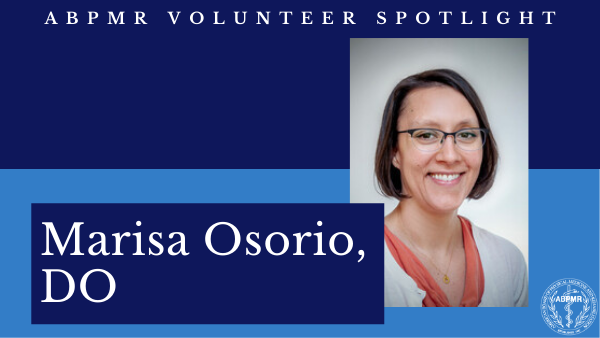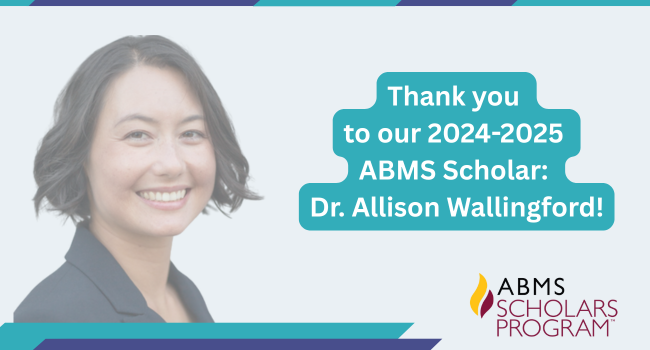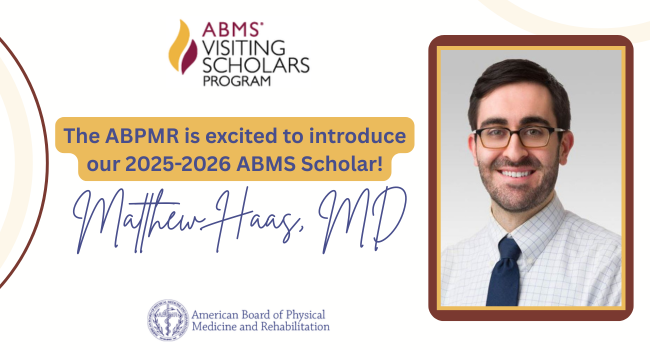Physician Features
Volunteer Spotlight: Marisa Osorio, DO

The April Volunteer Spotlight feature is Marisa Osorio, DO. Dr. Osorio is division chief at Seattle Children’s Hospital and associate professor of Rehabilitation Medicine at the University of Washington. Dr. Osorio became board-certified in PM&R in 2010 and has been subcertified in Pediatric Rehabilitation Medicine (PRM) since 2012. She currently volunteers with the ABPMR as an item writer for the PRM Examination.
We spoke with Dr. Osorio about her decision to pursue PM&R, her experience as an item writer, and what she loves about living in Seattle.
Where did you go to school?
I went to Washington & Jefferson College in Pennsylvania for undergrad, and took some time off before medical school to work for Americorps doing community outreach. I then attended medical school at Ohio University College of Osteopathic Medicine [now Heritage College of Osteopathic Medicine]. I went to the University of Cincinnati for my residency and did a pediatric rehab fellowship at Cincinnati Children’s Hospital.
What made you decide to spend time with Americorps?
I wanted to explore what else was out there and if I was truly committed to medicine. I found Americorps and there was the health and community wellness component to it, so that gave me an opportunity to see if the decision to pursue medicine was the right one. I also got to do outreach in women’s health all over southeast Ohio during that time, which was important to me.
How did you choose PM&R?
I had no idea about PM&R when I went into medical school! I wasn’t exactly sure what I wanted to do. Some colleagues had mentioned PM&R and said, “You should look into this because it fits the DO philosophy of a holistic approach.” I looked into PM&R and was enamored with it— I could help patients by caring for them as the whole person while helping with function and quality of life.
How did you get to Seattle from Ohio?
I knew I wanted to broaden my horizons, and there were some fantastic mentors in the Seattle area that I got connected with through my wonderful mentors at Cincinnati Children’s. The west coast seemed like a great fit for me and is an amazing place to be.
What does a day look like for you at Seattle Children’s?
I became the division chief of our department in 2021. I’m excited about mentoring this group of great providers to nurture their careers. My clinical passions surround caring for kids with cerebral palsy, tone management, and working in the brachial plexus clinic. My research is in tone management and brachial plexus. I have also been the PRM fellowship program director since 2014, but will transition out of that this year.
When did you start as an ABPMR volunteer?
I started just pre-pandemic in 2019. I had sent a letter to Dr. [Sherilyn] Driscoll [ABPMR Board Director], and said I was interested in becoming an item writer. There was opportunity available so I’m now an item writer for the PRM Examination!
Why did you choose to start as an item writer?
There’s a lot of practice that goes into writing questions. With my role as a fellowship program director, I wanted to work on my skills as an educator, and see how people are learning and how exams are set up. When you go through item writing and develop the questions, it helps to think globally about the question and how to teach. It fit well with medical education and gave me an opportunity to review the current literature and keep learning.
What keeps you coming back to volunteer?
There’s the duty of service and helping to advance our field. It’s important for the PRM field to continue growing and make sure everyone entering the field is well-equipped to serve the kids.
Do you have any memorable volunteer experiences?
The people who are senior to me and reviewing the questions I write are people I’ve worked with, so it’s lovely to see them in that capacity and collaborate with them!
What would you say to someone considering volunteering?
I’ve sent some folks to the ABPMR to volunteer! I have colleagues who want to contribute to the field, and I tell them, “You might like volunteering because it gives you the chance to continue in the academic realm and provides opportunity for lifelong learning.”
What do you outside of work and volunteering?
I spend a lot of time with my family. I have a wife and a 5-year-old, and we do lots of Seattle fun things like hikes, enjoying time on the water, outdoor recreation. When we’re hanging out close to home, it’s coffee shops, breweries, playgrounds, and biking. Lots of biking!
Thank you for your work as an ABPMR volunteer, Dr. Osorio. To all ABPMR volunteers who have dedicated so much of their time and effort to the field of PM&R: thank you! If you are interested in volunteering for the ABPMR or exploring a new role, please visit our volunteer page.



